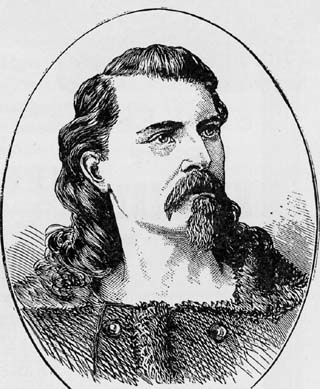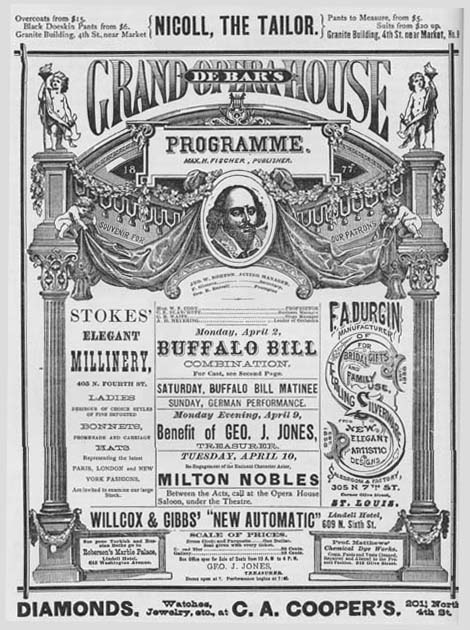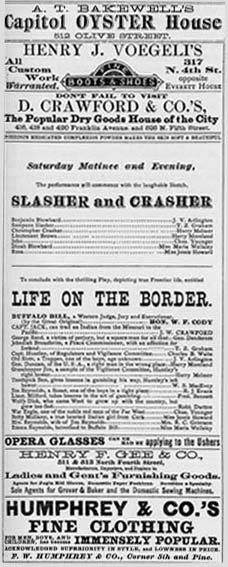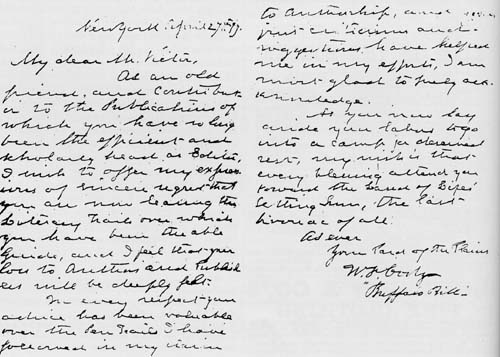
| Home | Information | Contents | Search | Links |
 |
Draw him strictly, so
That all who view the piece may know
He needs no trappings of fictitious tame.
DRYDEN
William Frederick Cody, scout and showman, made famous in part by the fiction written about him, was born on a farm in Scott County, Iowa, February 26, 1846, the fourth of the eight children of Isaac and Mary Ann (Leacock) Cody. His father was an unsuccessful farmer, and when William was five years old the family moved to LeClair, a one-horse village on the Mississippi, much run down since steamboat days. Here his older brother Samuel was killed by being thrown from a horse. Two years later the family went to Weston, Platte County, Missouri, and †February 19, 1864 to a trading post which the father had established in Leavenworth County, Kansas. In 1855, William began to work for Russell and Majors (afterwards Russell, Majors and Waddell) herding cattle at twenty-five dollars a month. He continued working for them most of the time during the succeeding seven years; for a few months as a pony-express rider,(1) then as driver and wagon-master.
After his father's death in 1857, William became the chief support of his mother, although he was but eleven years of age. In 1862 he joined the Ninth Kansas Cavalry as guide and scout on an expedition against the Indians, and in 1864 he enlisted †as a private in Company H, 7th Kansas Cavalry Volunteers, and was mustered out as a private, September 29, 1865. (Report of the Adjutant General of the State of Kansas, 1861-65, I, Leavenworth, 1867.)
On March 6, 1865, he was married to Miss Louisa Frederici, of St. Louis, and afterwards ran a hotel for a few months; then again acted as a scout. In 1867-68 he was hunter for Goddard Brothers, who had a contract for boarding employees of the Kansas Pacific Railway construction gang, and in less than eighteen months he is said to have killed 4,280 buffaloes. Being used for food, their ghosts probably never haunted him as they might have done had they been little pigs killed for a pipe-dream. His sobriquet, "Buffalo Bill," was given to him by the railroad hands at this time, but it was popularized by Ned Buntline,(2) who used him as the principal character in a number of sensational novels.
In the autumn of 1872, he was elected to the Nebraska Legislature from the 26th District, but he resigned after three weeks, saying that it was only fooling away time to make laws that nobody obeyed. He then joined Ned Buntline in a theatrical venture.(3) Picking up Texas Jack Omohundro, he went to Chicago where they met Buntline, who took them, on Wednesday, December II, 1872, to see the manager of the theater where they were to open on the following Tuesday. When the manager learned that the play had not yet been written and that the company had not been engaged, he refused to have anything to do with it, so Buntline himself hired Nixon's Theatre for the week of December 17 to 21 for six hundred dollars. He then sat down and, according to Cody, in four hours wrote the play "The Scouts of the Prairie." Buntline took the part of Cale Durg. Neither Cody nor Texas Jack, according to the former, could learn his part, consequently at the first performance they ad libbed throughout but made a hit. Cody, in the telling, probably made this out to be much worse than it really was, for he was likely to exaggerate if he could give a story a humorous turn. The play was taken to St. Louis the following week, and afterwards to Cincinnati, New York, and Philadelphia, playing to crowded houses everywhere. A week in Boston brought receipts of $16,500. After the close of the season, Cody and Texas Jack went hunting, but †not being satisfied with the settlement of the financial affairs of the past season, they parted from Buntline, and in the autumn they reorganized the theatrical company with Wild Bill as an additional attraction. Bill remained the greater part of the season, but when he amused himself by shooting blanks at the supers' feet, Cody protested and Bill quit. The next season, Texas Jack was absent from the company, but in 1875-76, he and Cody were again together. In the summer of 1876, after the close of the season, Cody joined his old regiment, the Fifth Cavalry, as guide and chief of scouts, during the Sioux War. In the fall of 1876 he was on the stage once more with a new play, "Life on the Border," and had Captain Jack Crawford as one of the attractions. In the meantime, he and Frank North had started a cattle ranch sixty-five miles north of North Platte, Nebraska, and during the summer he spent his time there. Leaving Major North in charge of the ranch, he got some Sioux Indians to accompany him on his theatrical tour, 1877-78, which opened at the Bowery Theatre, New York, September 3, 1877, with a new play, written by Major A. S. Burt, and founded on the Mountain Meadows massacre and life among the Mormons, called "May Cody; or, Lost and Won." The next season he added more Indians to his show, and had with him also C. A. Burgess, a government interpreter, and his brother Ed. A. Burgess, known as the "Boy Chief of the Pawnees." After the close of the 1882-83 season, in association with Dr. William F. Carver†(4) and Major John M. Burke, he organized his Wild West Show, after the plan of one tried by Wild Bill in 1870 which had failed. He opened in Omaha May 17, 1883. Dr. Carver dropped out at the end of the season and Nate Salsbury became his partner, and so remained until †his death. The Wild West show played in Europe three different times.

†Program of Buffalo Bill's play at De Bar's Grand Opera House, St. Louis, April 2 to 10, 1877. |

|
Cody retired as †owner of his own show, November I, 1911, †then was with the Sells-Floto circus and finally, in 1915, with the Miller Brothers '101 Ranch. He died in Denver January 10, 1917. He was buried on Lookout Mountain, overlooking the plains he loved so well. His wife died in 1921, and was buried beside him.
It has often been said that the novels ascribed to Cody were all written by Buntline, Ingraham, or Major John Burke. It is doubtful whether Buntline ever wrote under Cody's name. Ingraham certainly did, but it is also equally certain that Cody wrote some himself, although they may possibly have been corrected by † or someone else. It is true that his schooling was not great. In the winter of 1855-56 he went to school, and later a Miss Jennie Lyons was engaged as a teacher for the Cody children. In 1859 he again went to school for a few months. However, many a man with little schooling became a great writer. Ingraham(5) said that the border novel brought Colonel Cody to the front as a writer, and that he dictated his first novel to a stenographer. Jenks(6) said that later when Cody got tired of making "copy," Ingraham ghost-wrote for him. Cody himself wrote(7) that he had written about other scouts and pioneers, such as Daniel Boone, Davy Crockett, and Kit Carson because the surroundings in which they lived were particularly pleasant to him.
Cody's sister Helen(8) also wrote of his literary efforts. She said that his school days were few in number, consequently his first sketch for publication was short on punctuation and capitals. But he was determined to succeed, and by study was soon able to send clear, grammatical and well-spelled manuscripts to the publishers, and received good prices for his stories. In a letter to his publishers he once apologized for lying so outrageously, but said he understood that that was expected in stories of the border. If revolver or bowie knife were used too freely, he asked them to cut out whatever they thought best.
In a two-page autograph letter (Fig. 188), now in the possession of Dr. Frank P. O'Brien, written by Cody to O. J. Victor and included in a portfolio of letters from the Beadle authors and presented to Victor on his retirement as editor for Beadle and Adams, Cody spoke of himself as an old friend and contributor to the publications of which Victor had so long been the efficient and scholarly head. It is highly improbable that Cody, in a personal letter included with letters of other authors in a memorial volume not intended for publication, would speak of himself to his editor as one of his authors unless he actually was a writer in fact. It is immaterial that some of the later tales were ghost-written. The fact remains that Cody undoubtedly did write for Beadle.
That Colonel Cody could tell interesting stories is also attested by Ingraham(9) who spoke of him as "an inimitable story teller," and Colonel Visscher(10) said: "Many a time have I seen the Colonel, an island in an ocean of small boys, telling them stories of the past. And what wonderful stories they would be!"
† Furthermore, in a letter to me (December 28, 1951), R. Farrington Elwell, who "was associated with Cody for many years in as close a relationship as father and son," and who handled Cody's ranch business in Wyoming, wrote, "As to the Colonel's literary work, he wrote some of the very early novels himself; that is to say, quite a number of novels were written entirely by him and used just as written.

I have devoted considerable space to proving that Cody did write at least some of the tales attributed to him in an attempt to convince certain doubting Thomases among my friends who insist that Cody was not able to write any of his own stories. However, as Fritz Reuter said in "De Jagdgeschichten," "En Jeder glowt man wat em passt, Dat Anner is em verdachtig," so perhaps it is too much to hope that they have been converted to my way of thinking!
Among writings attributed to Cody were his Autobiography; Story of the Wild West and Camp-Fire Chats (Philadelphia, 1888), Turning the Trackless Plains Into an Empire (1916), The Adventures of Buffalo Bill (1904), True Tales of the Plains (New York, 1908), and (with Harry Inman) The Great Salt Lake Trail (New York, 1898 and Topeka, 1913). Incidentally, believe it or not, there is a story by Cody entitled "Prairie Prince, the Boy Outlaw; or, Trailed to His Doom," in the Saturday Evening Post, LV, No. 12, October 16, 1875.
It is difficult to separate the novels written by Buffalo Bill from those written under his name by Prentiss Ingraham. There is no definite date when one ended and the other began, for both seem to have been writing for a certain period under Cody's name. In the list below, therefore, all of the novels credited to him in the Beadle publications are listed.
REFERENCES: Cody's Autobiography; Helen Wetmore Cody and Zane Gray, Last of the Great Scouts, New York, 1899; Louisa Frederici Cody and Courtney Ryley Cooper, Memories of Buffalo Sill, 1919; Alexander Majors, Seventy Years on the Frontier, Chicago, 1893; Henry Llewellyn Williams, Buffalo Bill, Rifle and Revolver-Shot, Pony Express Rider, Teamster, Buffalo Hunter, Guide and Scout, London, 1887; Richard J. Walsh, The Making of Buffalo Bill, Indianapolis, 1928; Who's Who, I, 1899-1900; Nat. Cyc. Amer. Biog., V, 1907, 483, with portrait; Prentiss Ingraham, "Buffalo Bill's Boyhood," Golden Hours, XXVII, April 13, 1901, with portrait. A three-column biography, with portrait, is given in the Banner Weekly, No. 669, September 7, 1895, and there are almost weekly items about him in the same paper in the late 1880's and early 1890's. Obituary notices in many newspapers January 10, 1917, et. seq. Also innumerable newspaper and magazine articles. A picture of Cody in his old age appeared in the National Police Gazette, LXXXV, Dec. 3, 1904. A picture of Cody on a white horse was given as a supplement to the same paper, No. 1239, LXXVIII, May 18, 1901†. Dan Muller, My Life with Buffalo Bill, Chicago, 1948. †Arthur Sears Henning, "Buffalo Bill's Suit for Divorce," Chicago Daily Tribune, January 8, 1954, with portraits of Buffalo Bill, Katharine Clemmons Gould, and E. Z. C. Judson. Charles Boswell and Lewis Thomson, "The Man Who Built Buffalo Bill," True, July, 1956, 32-33, 96-108. Don Russell, "Buffalo Bill's Greatest Show," Westerners' Brand Book, Chicago Posse, XVII, No. 8, October, 1960 (corrects many errors of previous writers). J. Edward Leithead, "By the Author of Buffalo Bill," ibid., No. 308, May, 1958; No. 309, June, 1958; No. 310, July, 1958. Don Russell, The Lives and Legends of Buffalo Bill, Norman, 1960, 514 pages, 26 illustrations, 4 maps.
Saturday Journal. Nos. 287, 293, 315, 341, 426, 472, 518
Beadle's Weekly. Nos. 28, 40, 67, 77, 89, 101
Banner Weekly. Nos. 157, 169, 615, 752
Twenty Cent Novels. No. 27
Dime Library. Nos. 52, 83, 243, 304, 319, 394, 397, 401, 414, 599, 639, 800, 807, 820, 839, 969, 973
Half-Dime Library. Nos. 3, 19, 55, 68, 158, 1029, 1038
Pocket Library. Nos. 2, 6, 39, 52, 117
SPECIMEN OF WILLIAM F. CODY'S STYLE
"Kansas King; or, The Red Right Hand." Half-Dime Library No. 3, page 4.
More and more mystified by everything he had discovered in the Black Hills, Red-Hand walked rapidly away in the direction of his camp, and after nightfall arrived to find another surprise awaiting him, for an old trapper had come in and told his story of how he had been hunting on the streams, and had struck the trail of the party coming to the Hills.
Feeling assured that there was something beyond his comprehension, he determined to strike the trail and follow it up, to see what could carry a party into the Black Hills.
The second night after starting upon the trail he camped in a piece of timber bordering the bank of a small stream, and was soon fast asleep, to be awakened an hour after by the arrival of a train of emigrants, who were also moving for the Black Hills.
From his retreat he observed that the train consisted of some thirty pack-mules, instead of wagons, and about twenty men, all splendidly armed, while there were as many women and children accompanying them.
Not wishing to make himself known, for he believed from all he saw that the expedition was a secret one, the old trapper lay quiet all night, and at early dawn the party arose and continued on their journey directly toward the Black Hills, and following the trail of the party that had gone before.
"Did you see the party again after that night, Lone Dick?" asked Red-Hand of the old hunter, whom he had met in the settlements now and then, and knew as a brave man who always tramped alone, and never meddled with the affairs of other people.
"No, I skarted round them and struck your trail ag'in, and then come on, and here I is," replied Lone Dick, who was a real frontiersman in appearance and dress.
"And why did you follow us, Lone Dick?"
"I'll tole you. Yer see, Red-Hand, I has hearn how there was yellow metal up in these diggin's, and when I see's yer trail I knowed as how somethin' was up, and I detarmined to nose it out, kase I'se been workin' at traps nigh onto twenty year, and I ain't got no fortin' yet, and I felt as how ef yer was a good set of fellers you wouldn't mind havin' another true rifle and arm with your'n, for this is an all-fired dirty Injin country, you know."
"Yes, and I have no objection to the aid of your good arm, Lone Dick, and will tell you frankly we did come here to prospect for gold, and kept it dark because the government would send troops after us. But, Lone Dick, I do not understand about the train you speak of, and think it strange that settlers should come into these hills, bringing their wives and children with them." "It's all-fired strange, Scout; but we kin soon nose out what they're doin' here, and whar they're goin' to squat."
"True, and you and I will start on a scout in the morning, and follow up their trail, while the boys are busy putting up a log fort, for the Sioux are not going to let us have peaceful possession here, and will soon discover that five of their warriors were scalped to-day," said Red-Hand.
"What? Blazes! did yer riz the h'ar of five to-day?" asked Lone Dick and the remainder of the party gazed upon Red-Hand in surprise, while he quietly replied:
"I had a little skirmish to-day; not of my own seeking, however," and tossing the bundle of Sioux scalp" to Lone Dick, he rolled himself in his blanket and soon appeared to be fast asleep.
† Correction made as per Volume 3.
Notes
| 1 | There is some doubt as to whether Cody was actually a regular pony express rider. One of the requirements of the pony express was that the riders be at least twenty years of age. When the pony express ended November 18, 1861, Cody was not yet sixteen years old. |
| 2 | See under the biography of E. Z. C. Judson, below. |
| 3 | † For a biography of Dr. Carver see Raymond Thorpe, Spirit Gun of the West, the Story of Doc W. F. Carver, Glendale, California, 1957. A review of this book is given in the Westerners' Brand Book, Chicago Posse, XIV, No. 8, 61-62. |
| 4 | Cody visited New York in 1872, and while there saw a play which had been written by Fred Maeder, based upon a story that Ned Buntline had written for the New York Weekly in 1869, called "Buffalo Bill, the King of Border Men." The part of Buffalo Bill was taken by J. B. Studley, and the part of his sister by Mrs. W. G. Jones. Cody was present at the opening night and was called upon for a speech, but was much embarrassed, and said that his utterances could not be heard even by Mr. Dean, the leader of the orchestra, who was sitting only a few feet away. Perhaps this stage appearance predisposed him later to join in Ned Buntline's new theatrical venture.
† There has been considerable confusion concerning the various plays in which Buffalo Bill took part. Don Russell, in various letters to me between 1954 and 1956, summarized them as follows: † The first play about Buffalo Bill was written by Fred Maeder, who based it upon Ned Buntline's story "Buffalo Bill, the King of Border Men," which had appeared in the New York Weekly several years before. With this play Buffalo Bill had nothing to do, although in his autobiography he speaks of seeing it in New York. Following this came the play mentioned above, written by Ned Buntline himself and first performed in Chicago in December, 1872. It was entitled "The Scouts of the Prairie" and had as the three principal characters Buffalo Bill, Ned Buntline, and Texas Jack. A partial cast of characters is given in a playbill reproduced in The House of Beadle and Adams, II, 173. The complete cast is given by Herschel C. Logan in his Buckskin and Satin, 71-72. The next season, beginning in the autumn of 1873, Buffalo Bill had a new play written by Hiram Robbins (according to Richard J. Walsh in The Making of Buffalo Bill), entitled "The Scouts of the Plains." Logan gives a cast of characters (p. 88), although he ascribes the play to Maeder. The cast of characters, however, is entirely different from those in Maeder's play. The final play was entitled "Life on the Border." It first appeared in the autumn of 1876. A playbill of its appearance at De Bar's Grand Opera House in St. Louis, April 2, 1877, is given in The House of Beadle and Adams, II, 59, and shows that this likewise is entirely different from all the others. |
| 5 | Prentiss Ingraham, "The Classic 'Dime Novel' and its Gradual Disappearance," New York Herald, February 3, 1901. |
| 6 | George C. Jenks, "Dime Novel Makers," The Bookman (New York), XX, October, 1904, 112. |
| 7 | William F. Cody, "The Life of Hon. William F. Cody, known as Buffalo Bill, the Famous Hunter, Scout and Guide. An Autobiography." Hartford, 1879. First page. Many editions. |
| 8 | Helen Cody Wetmore, The Last of the Great Scouts, Duluth, Minn., 1899, 200-201.
Mrs. Wetmore had been referring to the Indian trouble of 1875, and said that Buffalo Bill began to write at "this period of his life." And this, as it so happens, was the year in which the first novel accredited to Cody appeared. "The Pearl of the Prairies; or, The Scout and the Renegade" was printed in the New York Weekly, XXX, August 9, 1875, and just a month later his story "Deadly-Eye" was begun as a serial in the Saturday Journal, No. 287, September 11, 1875. A short story, "The Haunted Valley; or, A Leaf from a Hunter's Life," had appeared even earlier in Victory's Fireside Visitor, VI, April, 1875. |
| 9 | Prentiss Ingraham, footnote in Dime Library, no. 794, p. 7. |
| 10 | Life and Adventures of Buffalo Bill. Memorial edition with Preface and final chapter by Colonel William Lightfoot Visscher. Chicago (1917), 345-46. |